What is man to man defense in basketball
Man to man defense is a type of basketball defensive system that emphasizes each defender guarding a certain offensive player, typically based on their respective basketball positions, to ultimately limit or prevent scoring opportunities near the basket or near the perimeter areas of the court.
What are the general differences between man to man defense and zone defense
Coverage
The primary difference between man to man defense and zone defense is that within man to man defense, each defender covers a specific offensive player while in zone defense, each defender covers a specific area of the court.
On-ball pressure
Also, in man to man defense, the defender that is currently guarding the offensive player with the ball will typically apply a certain amount of defensive pressure within that offensive player’s space.
However, in zone defense, the defender that is currently guarding the offensive player with the ball may or may not apply a certain amount of pressure. This typically depends on the type of zone defense.
For example, in certain types of odd-front zones such as the 1-3-1 zone defense, there will be a certain amount of defensive pressure applied to the player with the ball, particularly at the top.
On the other hand, in even-front zones such as the 2-1-2 zone defense, applying much defensive pressure is usually optional and more so utilized when the defensive team is executing a type of match-up zone defense.
Ball side help defense
Another distinction between man to man defense and zone defense is the methods in which each type of basketball defense system employs ball side help defenders, specifically once the ball is in the half court.
In man to man defense, when the ball gets passed to one side of the floor, the off-ball help defender will typically jump to the ball to take away certain cuts or dribble penetration opportunities.
Furthermore, in certain instances, a help defender could also execute a defensive stunt at the ball to limit dribble penetration as well.
However, in man to man defense, off-ball help defenders on the same side of the ball in the half court should usually not attempt to double team or set traps with the adjacent on-ball defender.
The main reason being is because the off-ball defender on the same side as the adjacent on-ball defender is only one pass away from the offensive player that they are currently guarding.
What this basically means is that the offensive player with the ball only has to execute one pass out of a potential double team or trap to the off-ball defender’s assignment.
From that point, the off-ball defender will generally not have enough time to recover to their own assignment and this could lead to an uncontested jump shot or dribble penetration towards the basket.
Conversely, in zone defense, it is possible in some situations for an off-ball help defender on the same side of the ball to double team or set traps in the half court.
The reason that this is viable is because zone defenders cover areas of the court as opposed to actual offensive players.
Furthermore, the general purpose of zone defenses is to typically keep the ball out of the low post area and/or influence perimeter jump shots.
As a brief example, let’s say an offensive team has a dominant low post player and this same low post player receives the ball against a zone defense.
Let’s also say that the offensive team has one or two below average three-point shooters on the same side of the court, near the wing and corner, as that highly skilled low post player as well.
From that point, it is possible for the on-ball zone defender and an adjacent off-ball zone defender on the same side to double team the low post.
In this particular case, even though the off-ball zone defender is helping one pass away, it is what the defensive team wants because the perimeter players on that side have below average shooting skills.
Gap protection
Another difference between man to man and zone defense is the amount of gap protection within the overall defensive systems or strategies.
In man to man defense, when the off-ball help defender jumps to the ball, this not only prevents or limits certain cuts to the basket or dribble penetration opportunities, it also allows that defender to fill the single gap space in that adjacent area, at least momentarily.
It is that actually filling of the adjacent gap space which limits or prevents the basket cut or dribble penetration. This, in turn, also hinders potential scoring options for the offensive team as well.
Furthermore, when the ball gets passed to a corner which is two passes away from the top, the off-ball help defender near the top will drop back to protect the nail area at the center of the free throw line.
This nail protection enables the off-ball defender at the top to limit or prevent basket cuts, particularly from the top, or limit middle dribble penetration, especially from the wing areas.
On the other hand, within zone defense, the gaps could become extremely exposed and thereby exploited by the offensive team, depending on the type of zone that is utilized.
For example, the 2-3 zone defense has potential gap weaknesses in the middle near the high post area as well as the short corners near the back of the zone.
So, if the offensive team is able to get the ball into those particular gaps, this could cause the zone to break down and therefore, lead to scoring opportunities for the offense.
What is an advantage of man to man defense
One notable advantage of man to man defense is that it could be useful against offensive players with inadequate dribbling skills and/or offensive teams that prefer to score from the perimeter, particularly with three-point jump shots.
If an offensive team’s primary ball handler, which is usually the point guard, possesses at best, only average dribbling skills, then the man to man defense might become a problem for that same player as well as the offensive team as a whole.
Basically, the defensive team could use the man to man defense to apply maximum on-ball pressure against the primary ball handler and this could lead to limit scoring opportunities or even worse, turnovers.
Similarly, if the offensive team prefers to score from the perimeter, then the on-ball pressure of the man to man defense could influence the offensive team into taking contested jump shots.
What is a disadvantage of man to man defense
One particular disadvantage of man to man defense is that it might become a liability if the defensive team has one or more defenders with less than ideal footspeed or lateral quickness.
Essentially, the man to man defense requires all five defenders to work together as one unit, mainly by using speed and lateral quickness to stay in front of the player with the ball as an on-ball defender or to provide help defense as an off-ball defender.
Therefore, if one or more of the on-ball defenders does not have the footspeed or lateral quickness to consistently stay in front of their respective assignments, then this will put more undue pressure on the secondary help defenders.
If that occurs in a continuous fashion, it will almost certainly lead to multiple defensive breakdowns as well as scoring opportunities for the offensive team.
Furthermore, if one or more off-ball defenders is not able to provide sufficient help defense, particularly from the side of the court that is opposite of the ball (i.e. the weak side), then the offensive team will eventually create scoring options via the use of certain basketball screens or basketball cuts.
What are the fundamental concepts of man to man defense
Defensive stance
One of the fundamentals of man to man defense as well as basketball defense in general is the defensive stance.
To execute a proper defensive stance, each defender should have their feet slightly wider than shoulder width apart, their knees bent, and their back straight while maintaining balance.
Also, defenders should try to remain on the balls of the feet and not stand flat-footed.
Moreover, defenders should have their hands up with their arms extended away from their sides.
Additionally, on-ball defenders should have their hands mirror the ball. That is to say, if the ball is high near the offensive player’s chest or above the shoulders, then the hands of the defender should be high as well.
By doing this, the defender may be able to deflect the ball if the offensive player attempts to pass it to another teammate.
Conversely, if the ball is low near the offensive player’s hip (i.e. the offensive player is basically in a triple threat position), then the hands of the defender should be low as well.
Also, in that particular instance, if the offensive player is a good perimeter shooter, then the on-ball defender could have one hand near the face of the potential shooter while the other hand is near the ball.
This allows the on-ball defender the opportunity to take away a probable jump shot and at the same time, the defender is in a position to completely stop or at least, slow down any feasible dribble penetration by the offensive player.
In addition to that, it is important to note that an on-ball defender should not reach in aggressively in an attempt to steal the basketball from the offensive player. If that occurs, the defender could possibly get called for an unnecessary foul by the referee.
Defensive slide
Before executing the proper defensive slide, defenders should not stand flat-footed while in the defensive stance as mentioned previously.
Next, to execute the defensive slide, defenders should move their feet laterally from side to side with one foot leading the other.
For example, if a defender wants to move to their right (which would be the left side of the court from the offensive team’s point of view), then the defender should move laterally (from side to side) with the right foot leading first followed by the left foot thereafter.
Conversely, if a defender would like to move to their left (which would be the right side of the court from the offensive team’s point of view), then the defender should move laterally (from side to side) with the left foot leading first followed by the right foot afterwards.
Also, it is important to note that a defender should try to keep their feet as close to shoulder width apart as possible while executing the lateral slide. In other words, the defender’s feet should never be too close together as that would take away the defender’s lateral quickness.
Furthermore, it is also important to mention that a defender should not cross their feet when executing the lateral slide.
If that were to occur, not only does this eliminate the defender’s ability to effectively slide laterally, but it also could cause the defender to lose balance.
Moreover, as a side note, when defenders do not execute proper defensive sliding, this could lead to foul trouble by way of an accumulation of unnecessary personal fouls.
Protect the basket
Another key basic of man to man defense is to protect the basket at all times. Essentially, there should always be at least one on-ball or off-ball defender near the basket whenever feasible.
This is an important fundamental concept because having a defender near the basket prevents the offensive team from easily scoring around the basket without any defensive resistance.
In other words, if there is no defender near the basket, then an offensive player with the ball could either pass it to another teammate near the rim or execute dribble penetration towards the basket.
Afterwards, the offensive player with the ball or their teammate that received the ball could easily score by way of layups/dunks, which are the highest percentage shots in the game of basketball.
It should also be noted that while in standard half court man to man defense, as well as the full court man press, the defenders near the basket are usually the tallest and/or the best rim protectors.
However, during transition defense, this does not necessarily have to be the case. That is to say, when possession of the basketball changes (or transitions) from one team to the other, the team that does not have the ball is now on defense.
When that occurs, particularly after a missed shot or even after a live-ball turnover, any defender that is closest to the basket should get back to protect it as soon as possible.
As an example, there could be a situation during transition defense where the shortest player on the court (this is commonly the point guard) should get back and protect the basket.
By doing this, this mitigates or completely eliminates the offensive team’s ability to efficiently perform their transition offense, especially their primary break offensive actions.
Even if the defender is not able to prevent the opposition from scoring during transition offense, as long as they were able to protect the basket, then the offensive team still had to break through the defensive resistance.
Limit dribble penetration
In man to man defense, it is also essential for the defensive team to try and limit the offensive team’s ability to get dribble penetration, especially towards the middle of the lane.
If the offensive team is able to dribble penetrate towards the basket, especially towards the middle, then they could generate multiple scoring opportunities, which is not unfavorable for the defense.
Moreover, in some instances, when the ball is on the wing or in the corner, a defender near the top could drop back towards the center of the free throw line area.
This is generally referred to as the nail and the defender in that same free throw line area is protecting the nail.
What this does is further limit dribble penetration, particularly towards the middle from an offensive player on the wing.
Closeout to the ball
In man to man defense, when the ball gets passed to a defender’s assignment, that same defender should sprint to closeout the open space between themselves and their assignment that is now in possession of the basketball.
Generally speaking, to execute the defensive closeout, defenders should have a good defensive stance and sprint towards their assignment, particularly with long steps.
Additionally, defenders should use short choppy steps upon fully closing the space and defenders should also get at least one hand up, typically slightly above the shoulders of their assignment with the ball.
Jump to the ball
In man to man defense, when an offensive player with the ball passes it to an adjacent teammate, the defender that is guarding the offensive player that passed the ball should jump to the ball on the air time of that pass.
By jumping to the ball, the defender could prevent potential face cuts by the player that executed the pass.
In addition to that, the defender could also limit immediate offensive dribble penetration by the player that receives the ball from the initial pass.
Stunt at the ball
In certain situations within man to man defense, an offensive player with the ball near one of the perimeter areas will be able to beat their assignment and create dribble penetration into a gap of the defense.
Furthermore, as another possible scenario, a highly skilled low post player could also receive the ball and attempt to score near the basket.
To mitigate either of these particular issues, it is possible for an adjacent off-ball defender to stunt at the ball by momentarily stepping towards the offensive player with the ball and then recovering to the offensive player that the off-ball defender is currently guarding.
By doing this, the stunting off-ball defender may be able to hinder dribble penetration near the perimeter or disrupt the offensive rhythm of the low post player with the ball.
Deny the ball
When executing man to man defense, an off-ball defender could deny the ball one pass away from the offensive player that they are currently guarding.
This can disrupt the flow of the offensive team, especially if the offensive player being denied is one of the offensive team’s best players.
To deny the ball, the defender should put the foot that is opposite the ball in the middle of the denied offensive player’s body, usually between the feet of that same offensive player.
Furthermore, the defender should place the other foot that is closest to the player with the ball slightly above the offensive player that is being denied.
Next, the defender should place the forearm that is opposite of the player with the ball on the chest of the offensive player that is being denied.
After that, the defender should have their arm and hand that is closest to the ball fully extended in the passing lane between the offensive player being denied and the player with the ball.
Moreover, the defender should have the palm of their hand towards the ball. In other words, the defender should be able to see the back of their hand and not their palm.
This basically helps the defender deflect the ball if the offensive player with the ball attempts to pass it to the offensive player being denied.
What are the primary tactics to defend ball screens within man to man
The primary tactics to defend against ball screens within man to man defense are known as the hedge, ice defense, and drop coverage.
By using these tactics, the defenders will be able to potentially mitigate the effects of the offensive team’s pick and roll or pick and pop strategies.
Basically, when implementing man to man defense, the offensive team might try to counter it by using the ball screen (also known as the on-ball screen) against the on-ball defender.
The ball screen action is essentially a two-man game between the offensive player with the ball and their teammate that is setting the ball screen.
Additionally, it involves the on-ball defender that will fight through the screen, avoid it by going under it, or take it away with the ice defense tactic.
Furthermore, when the offensive screening action occurs, the screener’s defender that will also execute certain actions based on the ball screen defensive tactics.
Hedge
The hedge is a basketball defensive tactic in which a screener’s defender lifts above an on-ball screen to obstruct the intended dribbling route of the screen receiver and afterwards, that same defender typically recovers to the screener.
To execute the hedge, the screener’s defender should see the screen before it is fully set, call it out to the on-ball defender, and then quickly get above the screen just before or during the moment of the potential dribble penetration.
Afterwards, the screener’s defender should try to stay as close to the screener as possible upon moving above the screen.
Next, the screener’s defender should step into the dribbling pathway with a proper defensive stance as well as with the outside arm and leg.
Following that, the screener’s defender should recover to the original assignment (i.e. the screener) or another assignment, such as an off-ball switch.
Ice defense
Ice defense is a basketball defensive tactic which focuses on limiting scoring options from the side pick and roll action of the player with the ball as well as the screener who would typically roll to the basket after setting the screen.
To execute the ice defense, the on-ball defender will jump above the screen, parallel to the sideline, before it can be fully set as opposed to fighting through it or going under it.
Also, the screener’s defender should stay below the screen near the free throw line extended area inside of the three-point line.
The ice defense influences the offensive player with the ball towards the baseline and away from the screening action.
As a result of that, this takes away dribble penetration towards the middle of the court and it also possibly limits the scoring opportunities of the offensive team as the ball is only on one side of the floor.
Drop coverage
Drop coverage is a basketball defensive tactic in which a screener’s defender will drop below the screener, typically slightly above or below the free throw line area during a ball screen or pick and roll action by the offensive team.
To execute the drop coverage, the on-ball defender will fight over the top of the screen while the screener’s defender stays below the screen, usually in the lane, as previously mentioned.
The main purpose of the drop coverage is to restrict the roll action of the screener after setting the screen while influencing perimeter jump shots by the screen receiver.
Therefore, the drop coverage could be useful if the screener prefers to roll to the basket after setting screens and the offensive player with the ball (i.e. the screen receiver) has less than average perimeter shooting skills.
What is switching within man to man defense and why is it effective
Switch defense, also known as defensive switching, is a basketball defensive tactic in which two defenders exchange the offensive players that they are currently guarding to ultimately hinder or prevent offensive scoring opportunities near the basket or from the perimeter.
Switch defense is effective because it could potentially mitigate the effects of the offensive team’s mid-range or three-point jump shots by way of their off-ball or on-ball screens.
In other words, the offensive team will typically use a variety of off-ball screens such as the down screen or the on-ball screen to create scoring opportunities for their best shooters.
So, to counter that action, the defensive team could switch defenders during the process of the screening action to take away the jump shot altogether or at least, influence a contested one.
What are simple examples of man to man defense
Example 1
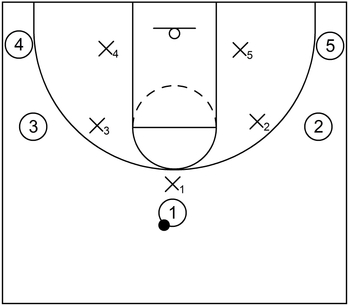
This is an example of man to man defense in the half court when the ball is at the top. Also, for this situation and the ones that follow, the offensive team uses the 5 out formation for demonstrative purposes.
To begin, X1 is the current on-ball defender and applies a certain amount of defensive pressure.
X2 and X3 are the adjacent off-ball help defenders that are one pass away from the ball. Therefore, both of them could be about a half-step or full step away from their respective assignments inside of the three-point line near the free throw line extended.
Also, by standing in those areas, X2 and X3 which gives them an opportunity to stunt at the ball if 1 was to dribble penetrate towards the basket from the top.
X4 and X5 are the furthest off-ball help defenders that are two passes away from the ball. Therefore, both of them could be about two steps away from their respective assignments.
Essentially, for this case, X4 and X5 could slide laterally towards the low post areas.
It should also be mentioned that all of the off-ball help defenders could use their pointer fingers to point to their assignment as well as the player with the ball.
This is commonly referred to as “ball-you-man” and it basically means that the off-ball defender (the ‘you’ of the phrase) should be between the ball and their assignment (the ‘man’ of the phrase).
Example 2
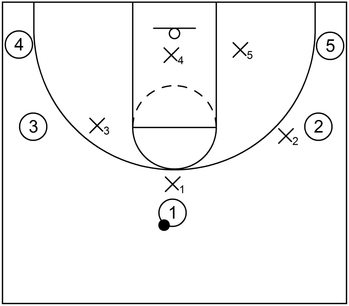
This is another example of man to man defense in the half court when the ball is at the top. For this case though, 2 is the offensive team’s best scoring threat. Therefore, X2 denies 2 from receiving the ball.
Also, once X2 denies, X4 could slide into the lane to protect the basket. The reason this is significant for this case is because X2 could become vulnerable if 2 uses the backdoor cut as a counter to the denial defense.
Moreover, X4 can slide into the lane because X4 (and by extension, their assignment, player 4) is two passes away from the ball. Therefore, if 4 were to receive the ball at the current position in the left side corner, X4 should have enough time to closeout to the ball.
Example 3
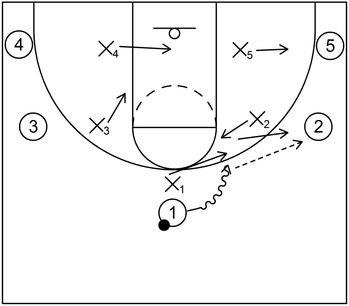
This is yet another example of man to man defense in the half court when the ball is at the top. This time, however, dribble penetration occurs from the top. When that happens, X2 can stunt at the ball to slow down the dribble penetration of 1.
Afterwards X2 could recover back to their respective assignment while X1 tries to get back in front of the ball.
Also, in this particular instance, the low post area on the same side of the ball is empty. Therefore, X4 should slide into the lane to protect the basket.
Furthermore, if 2 receives the ball from 1, then X2 has already recovered to become the new on-ball defender.
In addition to that, X5 can take one step closer to the assignment (offensive player 5) because the ball is now one pass away.
Moreover, X3 could drop back to the mid-post area between the left side wing and the left side corner, which for this situation, would be the weak side of the court.
It should also be noted that X3 could drop back towards that area of the court because X3 is two passes away from the ball and this will further allow X3 to implement the help the helper concept shown on another diagram later.
Example 4
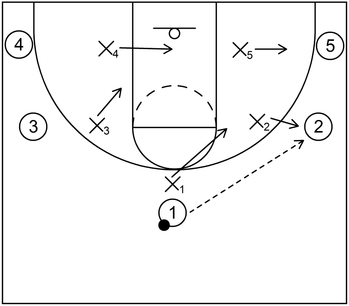
This is an example of man to man defense in the half court when the ball is at the top. However, this time, the ball gets passed to the wing when 2 receives it from 1.
When that happens, X1 immediately jumps to the ball while X2 applies on-ball pressure.
Also, X5 can take a step towards their assignment in the right side corner or even deny the ball in certain instances.
Furthermore, on the weak side, opposite of the ball, X4 could slide into the lane to protect the basket while X3 drops back to the mid-post area.
Example 5
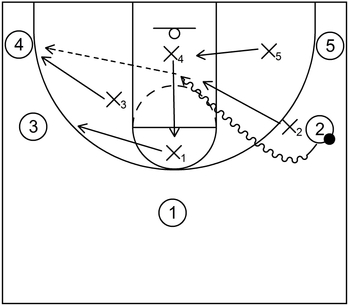
This is an example of man to man defense in the half court when the ball is on the wing. However, in this situation, X1 made a mistake by not jumping to the ball during the initial top to wing pass.
So, as a result, 2 is able to get middle penetration into the lane but X4 is there to protect the basket. After that, 2 executes the kick pass to 4 in the left side corner while X2 recovers.
When that occurs, X4 probably will not have enough time to closeout on the ball. Therefore, this triggers the defensive concept of helping the helper as well as multiple defensive rotations.
In simple terms, help the helper basically means an off-ball defender that gives initial help will receive secondary help themselves from another off-ball defender, especially after offensive dribble penetration occurs.
For this case, the initial helping defender is X4 and then, the secondary help defender will be X3. So, X3 should help the helper by closing out to the left side corner.
However, by helping the helper, X3’s assignment (i.e. offensive player 3) is left open temporarily. Therefore, to alleviate this potential issue, X3 (the helper) will also receive help.
So, X1 should slide laterally towards the left side wing to closeout on X3’s original assignment. Simultaneously, as that happens, X4 should fill and replace at the center of the high post to protect the nail.
What are examples of the full court man to man press
The full court man to man press is a variation of the standard half court man to man defense in which each defender guards an assignment from baseline to baseline, starting in the backcourt into the frontcourt.
The basic objective of the full court press is to simply implement more defensive pressure, particularly in the backcourt.
From that point, the added defensive pressure could potentially cause the offensive team to play faster than preferred and that could lead to more turnovers.
Example 1
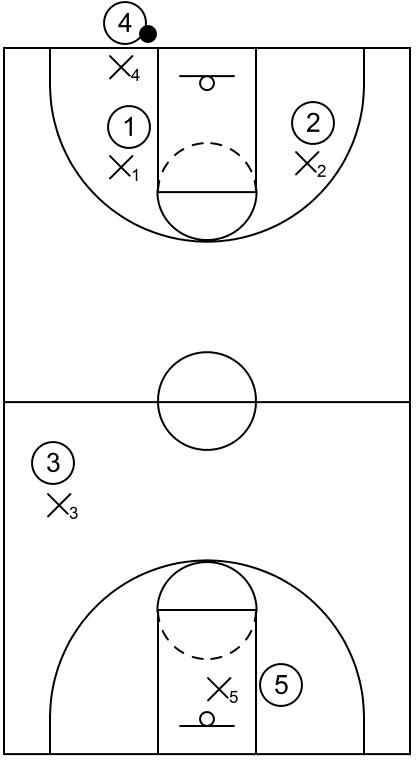
This is an example of the initial formation for the full court man to man press. In this case, 4 will inbound the ball and therefore, receives defensive pressure from X4.
1 and 2 are also in the backcourt and should receive pressure from X1 and X2 respectively.
3 is currently in the frontcourt but X3 is nearby to deliver defensive pressure if necessary.
5 is positioned near the low post and is currently being covered by X5 near the basket.
Example 2
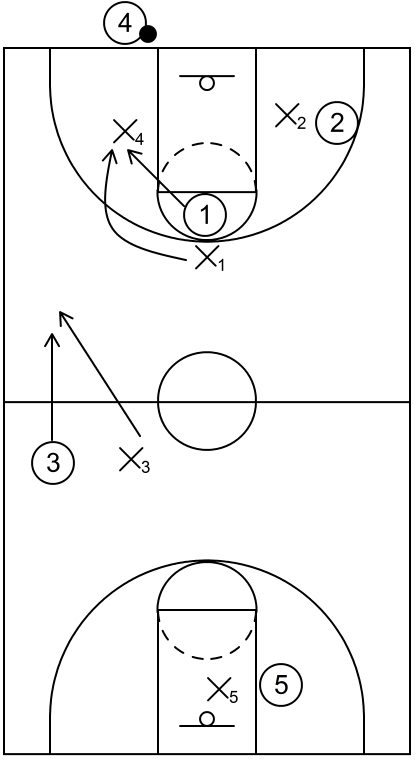
This is an example of the full court man to man press with denial principles. For this case, X4 does not pressure the ball in the backcourt during the inbound phase. Instead, X4 tries to deny 1 from receiving the inbound pass alongside X1.
Furthermore, 2 and 3 are also being denied from receiving the ball by X2 and X3 respectively while X5 continues to protect the basket.
Example 3
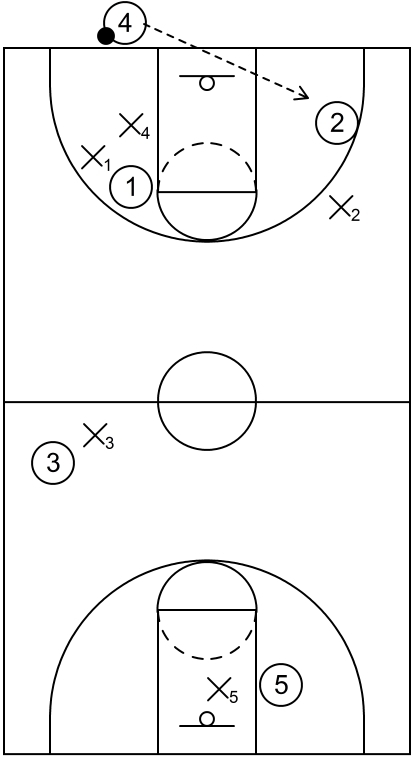
This is another example of the full court man to man press with denial principles, particularly in the backcourt. This time, it is assumed that 1 has above average ball handling skills while 2 has below average ball handling skills.
In other words, 1 can handle the defensive pressure but 2 might possibly turn the ball over while under pressure. Therefore, X1 and X4 attempt to fully prevent 1 from receiving the ball while X2 alleviates initial defensive pressure on 2.
Afterwards, 2 could receive the ball from 4 and then X2 could immediately step up with on-ball defensive pressure. Meanwhile, in the frontcourt, X3 covers 3 while X5 protects the basket.
Example 4
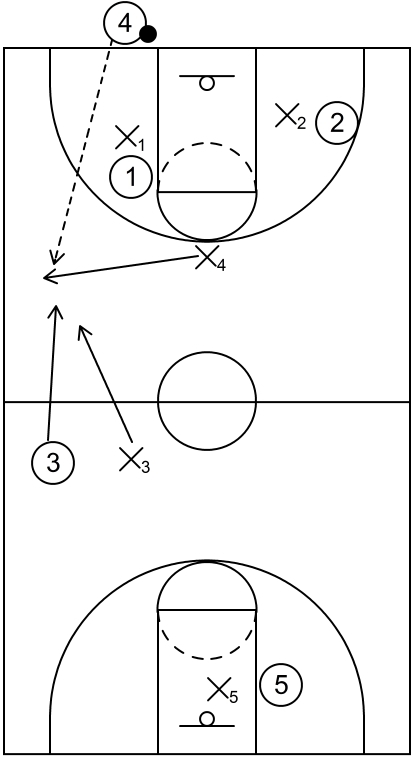
This is yet another example of the full court man to man press with denial principles in the backcourt. So, X1 and X2 try to deny the inbound pass to their respective assignments but this time, X4 drops back to the middle area instead of helping to deny or pressure.
The main purpose here is to encourage 3 to step up into the backcourt to receive the long pass from 4. However, X4 can try to intercept that pass and cause a turnover.
Moreover, if X4 is not able to intercept the ball, then X3 and X4 can set a trap near the sideline on 3 while X5 keeps protecting the basket.
Which basketball defensive strategies use elements of the man to man defensive system
The Amoeba defense is a basketball defensive strategy which seeks to limit scoring opportunities for the offensive team by implementing on-ball pressure as well as sideline traps while preventing dribble penetration from the perimeter and restricting entry passes into the high or low post areas.
The ball line defense is a basketball defensive strategy that implements on-ball defensive pressure and off-ball help defense principles to limit scoring opportunities near the basket while influencing contested perimeter jump shots.
The box and 1 defense is a basketball defensive strategy and a type of junk defense which seeks to limit scoring opportunities, especially for the opposing team’s best player, by implementing a combination of man to man and zone defense principles.
The diamond and 1 defense is a basketball defensive strategy, a type of junk defense, and a variation of the box and 1 defense which seeks to limit scoring opportunities, particularly for the opposing team’s best player, by implementing a combination of man to man and zone defense principles.
The pack line defense is a basketball defensive strategy that implements a combination of on-ball defensive pressure, help defense, and denial defense to limit or prevent offensive scoring opportunities, primarily by hindering low post touches and influencing contested perimeter jump shots.
The point zone defense is a basketball defensive strategy that emphasizes on-ball defensive pressure as well as off-ball zone defensive principles to ultimately limit or completely eliminate offensive scoring opportunities.
The run and jump defense is a basketball defensive strategy utilizes man to man principles, defensive traps near the sidelines, and the switch defensive tactic, particularly in the backcourt, to disrupt offensive flow and limit scoring opportunities near the basket or from the perimeter.